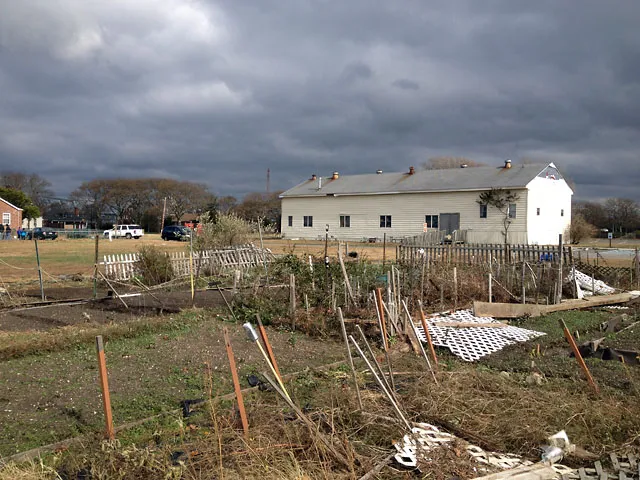The Beach Into The Farm
Not a second after we parked our van beside Ft. Tilden did we see the evidence of the storm surge over the peninsula. Chain link like a sieve, capturing, recording the evidence of the height, direction, and speed of inundation.
Walking into the park, eerily without guard or spectator, our feet sunk slightly into the still spongy grounds. The residents of the brick dwellings inside the park were pumping water from basements while their children played amongst the fallen trees and debris.
Is it an irony that the Ft. Tilden gardens look almost as bad after a storm surge as they normally do? The disorder of our community garden was the target of the National Park Service, our hosts, this autumn. Gardeners were asked to clean up their plots, which some had, but many had not. Most of the debris scattered down surge belonged to the unkempt plots. It was, in fact, thanks to some more tangled plots upsurge from the beach farm, that our plot had fared rather well. That is if you consider soil soaked with salty brine faring well.
 Just two weeks back I patted myself on the back for such excellent soil improvement in the tomato beds. These were prepared for Thanksgiving week's garlic planting. I marveled at the size and quantity of earth worms, the rich color and excellent tilth. But now, the beds were littered with desiccated earthworms; the water and salt too much for them. Earthworms rise to the soil surface whenever the soil becomes overly saturated. On Monday evening, they rose to find themselves under the sea.
Just two weeks back I patted myself on the back for such excellent soil improvement in the tomato beds. These were prepared for Thanksgiving week's garlic planting. I marveled at the size and quantity of earth worms, the rich color and excellent tilth. But now, the beds were littered with desiccated earthworms; the water and salt too much for them. Earthworms rise to the soil surface whenever the soil becomes overly saturated. On Monday evening, they rose to find themselves under the sea.In the garden shed was evidence of the water's height -silty striae cover all that stored inside. On the fences, deposits of plant litter suggested the movement of water across the peninsula. In the distance, white sand dunes splayed onto sports fields; the sea's glistening crenulations now visible from the farm.
Had there been much rain from the storm, our soils would have rinsed of some salt. Irrigation has been cut off since early October, so we cannot "wash" the soil of deposited salt. All we can do is wait for rain. How much contamination came with the water is difficult to say. The remaining water had not the oily film of flooded streets, so I can only reasonably assume this surge was as clean an ocean water as can be expected for the New York bight.
The remaining herbs, fennel bulbs, brassica, carrots, and Marie's strawberries had a grey film which clouded the air when disturbed. If the herbs survive the inundation, they will be cut back hard. We are forecast to receive a moderate nor'easter this Wednesday which won't be helpful to the recovery effort, but will help wash some of the salt through the soil.










Sorry to hear that Frank. Hope the plot out east for garlic next year fared better. (not so close to sea i hope?)
ReplyDeletetough tough year for a farmer. sorry, frank.
ReplyDelete